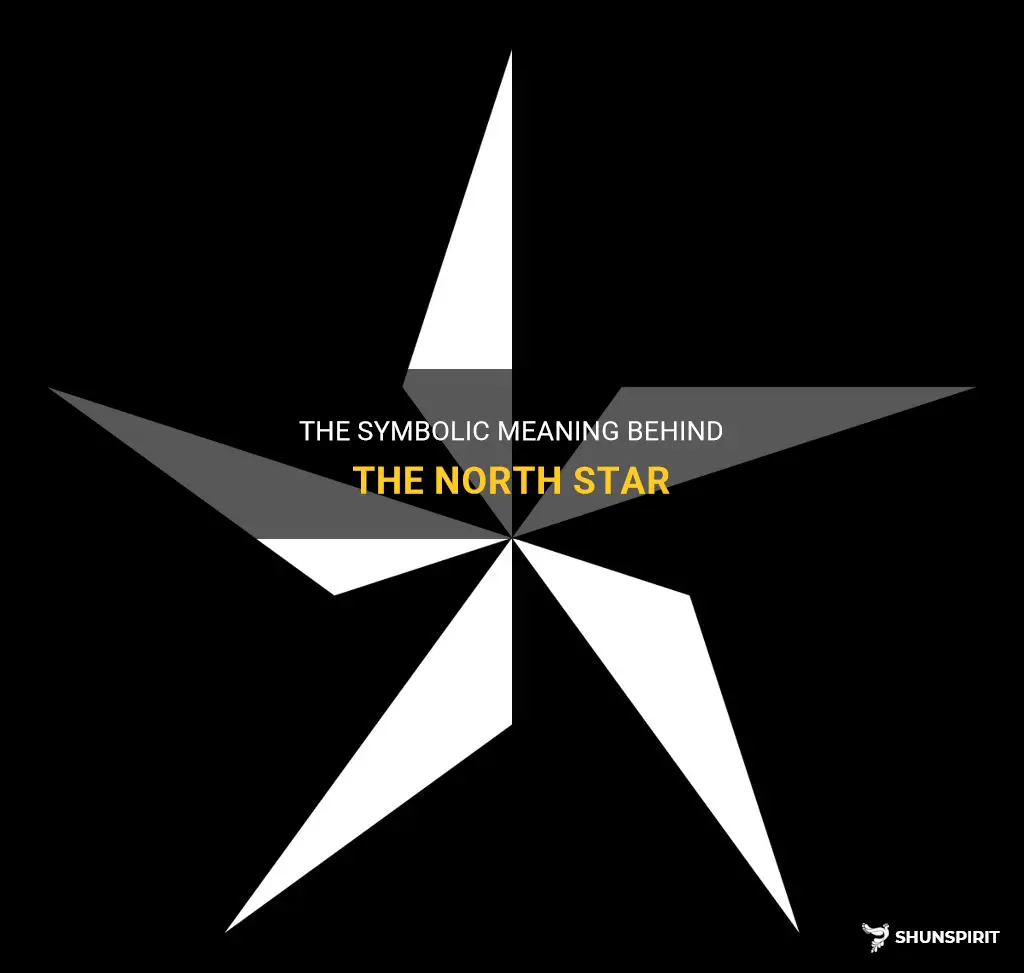
The North Star, also known as Polaris, has long been a powerful symbol with deep meaning for various cultures around the world. Its constant presence in the northern sky has made it a reliable guide for navigators, adventurers, and dreamers alike. Beyond its practical significance, the North Star has also come to represent hope, guidance, and a sense of purpose. Throughout history, this celestial beacon has served as a guiding light for those seeking direction in their lives, a reminder that even in the darkest of times, there is always a path to follow. Join us as we delve into the fascinating symbolism behind the North Star and uncover the rich tapestry of meanings it holds for different cultures and individuals.
What You'll Learn
- What is the origin of the North Star symbol and its meaning?
- How has the North Star symbol been used throughout history in different cultures and societies?
- In what context is the North Star symbol commonly used today?
- Can the North Star symbol have different meanings in different contexts or cultures?
- Are there any unique interpretations or symbolism associated with the North Star symbol in specific religions or belief systems?

What is the origin of the North Star symbol and its meaning?
The North Star is one of the most iconic symbols in astronomy and navigation. It has been used for centuries as a guiding light for sailors, travelers, and explorers. But where does this symbol come from and what is its meaning?
The North Star, also known as Polaris, is a heavily observed star in the night sky. It is located almost perfectly in line with the axis of Earth's rotation, which makes it appear stationary while all other stars appear to move around it. Due to this unique characteristic, the North Star has been used by various cultures as a reference point for navigation.
The origin of the North Star symbol can be traced back to ancient civilizations. Many ancient cultures believed that the North Star represented a fixed point in the sky that guided them on their journeys. In ancient Greece, the North Star was associated with the goddess Athena, who was believed to provide wisdom and guidance to travelers. In ancient Egypt, the North Star was associated with the goddess Isis, who was considered the divine mother and protector of the heavens.
In addition to its association with specific deities, the North Star also held a more general symbolic meaning. It was seen as a symbol of stability and constancy, as it remained fixed while the other stars appeared to move. This symbolism was particularly important for sailors and navigators, who relied on the North Star to guide them through the vast expanses of the ocean.
The North Star also played a significant role in various mythologies. In Norse mythology, the North Star was believed to be a giant ash tree known as Yggdrasil. This tree connected the different realms in Norse cosmology and served as a symbol of the cosmos itself. The North Star was considered the central point of this cosmic tree, representing the axis mundi, or the center of the world.
Today, the North Star continues to be an important symbol for navigation and guidance. It is still used by sailors, hikers, and explorers to find their bearings and find their way home. The North Star symbolizes the idea of finding one's true path and staying true to it, even when faced with challenges or uncertainties.
In conclusion, the North Star symbol has a rich history and a deep meaning across different cultures and time periods. It represents stability, guidance, and constancy, making it an enduring symbol of navigation and finding one's true path. Whether used as a literal navigational aid or as a metaphorical symbol, the North Star continues to inspire and guide people on their journeys.
Decoding the Toyota Tundra Dashboard Symbols: A Guide to their Meanings
You may want to see also

How has the North Star symbol been used throughout history in different cultures and societies?
The North Star, also known as Polaris, has been a symbol of guidance and navigation throughout history in various cultures and societies. It has played a significant role in maritime navigation and has been associated with symbolism, mythology, and spiritual beliefs. Let's explore how the North Star symbol has been used in different cultures and societies over the years.
In ancient times, the North Star held immense importance for sailors and explorers. Its position in the northern sky made it a reliable point of reference to determine direction, especially when far away from land. European sailors during the Age of Exploration heavily relied on the North Star to guide their voyages across the seas. It served as a constant guide, pointing the way to their desired destinations.
The North Star's significance extended beyond navigation. In various cultures, it has held deep symbolic meaning. In ancient Egypt, for example, the North Star was associated with the god Thoth, who was believed to be the ruler of time and knowledge. It represented wisdom, guiding individuals on their spiritual journey.
In Native American cultures, the North Star played a vital role in guiding tribes during migrations and journeys. It was seen as a symbol of hope, providing a sense of direction and purpose. Many tribes believed that following the North Star's guidance would lead them to safety and prosperity.
The North Star has also been used in astrology and mythology. In Greek mythology, the North Star was believed to mark the center of the universe. It was associated with the god Zeus and was considered a guiding light for humankind. In Chinese astrology, the North Star, known as Zǐwēi, is one of the twenty-eight mansions and is believed to bring good fortune and luck.
In spiritual beliefs and practices, the North Star has been regarded as a symbol of divine guidance. It has represented a guiding light leading individuals on their spiritual path. In some belief systems, it is seen as a representation of an enlightened being or a higher power watching over and guiding humanity.
Throughout history, different cultures and societies have used the North Star as a powerful symbol of guidance and navigation. Whether it was for physical journeys, spiritual quests, or symbolizing an enlightened being, the North Star has invoked a sense of direction, purpose, and hope. Its enduring symbolism continues to resonate in our modern world, reminding us to navigate our lives with purpose and stay guided on our own unique journeys.
The Spiritual Significance and Symbolism of Diamonds: Unlocking Their Hidden Meanings
You may want to see also

In what context is the North Star symbol commonly used today?
The North Star, also known as Polaris, has been used as a symbol throughout history in various contexts. Today, it continues to hold significance in multiple areas.
One of the most common uses of the North Star symbol today is in navigation and astronomy. The North Star has been highly regarded for centuries as a reliable guide for navigation, especially in the Northern Hemisphere. Due to its position in the sky, the North Star remains relatively stationary while the remaining stars appear to rotate around it. This makes it a valuable point of reference for sailors, hikers, and other individuals who need to find their way in unfamiliar territory. In the field of astronomy, the North Star is often used as a reference point to locate other celestial objects.
Moreover, the North Star is also used as a metaphorical symbol in various contexts. It is often associated with guidance, inspiration, and finding one's true north or purpose in life. In this sense, the North Star represents a beacon of light that helps individuals navigate through the challenges and uncertainties of life. It symbolizes the pursuit of personal growth, fulfillment, and the realization of one's dreams and aspirations.
Furthermore, the North Star has historical and cultural significance for different communities. In African-American history, the North Star was a term used to refer to Polaris, as it was believed to guide escaping slaves towards freedom. The Underground Railroad, a network of secret routes and safe houses used by enslaved African-Americans in the 19th century, used the North Star as a guiding point for their journey to freedom. As a symbol, the North Star represents hope, perseverance, and the pursuit of liberty.
In Native American culture, the North Star holds similar importance. It is often seen as a guide for tribes during their migrations, helping them navigate their way through vast territories. The North Star symbolizes guidance, wisdom, and a connection to the spiritual realm for many Native American tribes.
In conclusion, the North Star symbol continues to be used in various contexts today. From navigation and astronomy to personal growth and cultural significance, the North Star represents guidance, inspiration, and the pursuit of freedom and purpose. Whether as a literal point of reference or a metaphorical symbol, the North Star remains a powerful and timeless emblem in our ever-evolving world.
Decoding the Meaning Behind Mahjong Symbols: Unveiling the Secrets of an Ancient Game
You may want to see also

Can the North Star symbol have different meanings in different contexts or cultures?
The North Star, also known as Polaris, has long been a significant symbol in various cultures throughout history. Although its primary significance is as a navigational aid, guiding travelers in the northern hemisphere, the North Star can also have different meanings in different contexts and cultures.
In terms of navigation, the North Star has been a steadfast guide for sailors, explorers, and travelers for centuries. Due to its fixed position in the sky above the North Pole, the North Star remains relatively stationary while other stars appear to move throughout the night. This consistent presence allowed sailors to determine their latitude and stay on course during their journeys. In this context, the North Star symbolizes guidance, steadfastness, and reliability.
Beyond its navigational importance, the North Star has also acquired cultural and spiritual meanings in various societies. In ancient Egypt, the pole star was associated with the god Thoth, who was believed to be the creator of language and writing. The North Star was seen as a symbol of wisdom and knowledge. In Native American traditions, the North Star is often considered a guardian of the heavens and a symbol of direction and guidance. It is believed to provide a path for the souls of the deceased to reach the afterlife.
In Chinese culture, the North Star is associated with the celestial god Ziwei, who is believed to govern the fate and destiny of individuals. The North Star, therefore, represents luck, fortune, and the guiding force behind one's life path. In Taoist philosophy, the North Star is seen as the center of the universe, symbolizing balance, harmony, and spiritual enlightenment.
In modern times, the North Star has also taken on new meanings and associations. It has become a symbol of ambition, determination, and reaching for one's goals. The phrase "follow your North Star" is often used to encourage individuals to pursue their dreams and stay true to their inner compass.
It is important to note that while the North Star may have different meanings in various cultures and contexts, its primary significance as a navigational aid remains constant. The North Star's ability to guide travelers and explorers has been universally recognized, regardless of cultural interpretations.
In conclusion, the North Star is a symbol that can have different meanings in different contexts and cultures. From its navigational importance to its spiritual and cultural associations, the North Star represents guidance, wisdom, luck, balance, and ambition. Regardless of the specific interpretations, the North Star remains a significant symbol that has captured the imagination and awe of many throughout history.
What Does the Blue Symbol Mean on TikTok Sounds: Decoding the Mystery
You may want to see also

Are there any unique interpretations or symbolism associated with the North Star symbol in specific religions or belief systems?
The North Star, also known as Polaris, has been a guiding celestial object for centuries. Its mystical allure has led to various interpretations and symbolism in different religions and belief systems. Let's explore some of the unique associations linked to the North Star in specific spiritual practices.
In ancient Egyptian mythology, the North Star represented the goddess Isis. She was considered the mother goddess, the divine protectress, and the patroness of magic and fertility. The North Star, as a representation of Isis, was believed to provide guidance and protection to travelers, ensuring their safe journey.
In Norse mythology, the North Star, known as Lodestar or Hildskjalf, was associated with Odin, the supreme god of the Norse pantheon. Odin was considered the god of wisdom, poetry, and war. The North Star symbolized his all-seeing and all-knowing presence, guiding warriors and seekers of knowledge.
In Chinese astrology and mythology, the North Star holds special significance. It is associated with the deity known as the Celestial Emperor or the Jade Emperor. The Jade Emperor is believed to reside in the North Star and oversee the heavens. The North Star, in this context, is seen as a symbol of divine order, leadership, and balance.
In Native American spirituality, several tribes, such as the Cheyenne and the Lakota Sioux, have incorporated the North Star into their spiritual practices. It is seen as a symbol of steadfastness, guidance, and a connection to the spiritual realm. The North Star is often associated with the warrior spirit and is considered a reminder of one's purpose and direction in life.
In Islamic tradition, the North Star is not specifically mentioned, but astronomers and navigators have long relied on its position for guidance. In Islamic Sufism, the concept of the "Qutb" represents the spiritual axis or pole around which the world revolves. It is believed that the Qutb is a spiritual figure who embodies divine grace and guidance. Some Sufi scholars have associated the North Star with the Qutb, symbolizing divine guidance in the spiritual journey.
It is important to note that these interpretations and symbolism associated with the North Star may vary within and across different cultures, religions, and belief systems. The significance attributed to the North Star is often deeply rooted in the cultural and historical context of a particular spiritual tradition.
Regardless of specific interpretations, the North Star continues to inspire awe and wonder across various spiritual practices. Its unwavering presence in the night sky serves as a reminder of the interconnectedness of the universe and the eternal quest for guidance and purpose.
Decoding the Mystery: VW Dashboard Symbols and Their Meanings
You may want to see also
Frequently asked questions
The North Star, also known as Polaris, has long been associated with guidance and direction. It is a fixed point in the sky that can be used for navigation, particularly in the Northern Hemisphere. Therefore, the North Star symbolizes finding one's path or purpose in life and staying true to it.
During the time of slavery in the United States, the North Star held great significance for enslaved individuals seeking freedom. It served as a guiding light and a symbol of hope, as it was believed that following the North Star would lead them to freedom in the Northern states or Canada.
Yes, the North Star is always visible in the Northern Hemisphere. It remains in a fixed position above the North Pole, so as long as you can locate the Big Dipper constellation, you can easily find the North Star. However, its visibility may be affected by factors such as light pollution or atmospheric conditions.
Yes, the North Star holds cultural and spiritual meanings in various cultures around the world. For example, in Native American traditions, it is often associated with wisdom, knowledge, and guidance. In Norse mythology, the North Star is believed to be a guiding light for souls on their journey to the afterlife.
While modern navigation systems such as GPS have made it easier to determine direction, the North Star can still be used as a backup or for educational purposes. It can be a useful tool for outdoor enthusiasts, hikers, or sailors in situations where technology may not be available or reliable. Learning to locate the North Star and use it for navigation can be a valuable skill to have.







